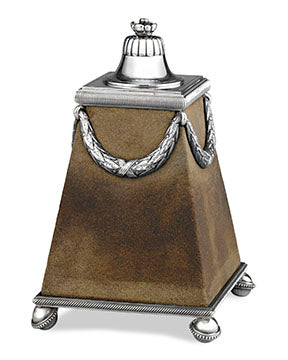
Fabergé Enameled Silver Kovsh
The public's appreciation and fascination with the works of Fabergé have continued unabated for more than 100 years. Born in 1846 to a modest jeweler of French Huguenot decent, Peter Carl Fabergé lived his life against the backdrop of one of the most powerful and glittering empires in history. The last Czars of Russia enjoyed an elegant lifestyle and the son of this St. Petersburg jeweler became the leading and most famed goldsmith, jeweler and designer of the Western decorative arts.
As a child, Fabergé attended the finest schools in Germany, Italy, France and England. By 1842, his father had established himself as the premier jeweler in St. Petersburg, dealing also in fine decorative objects, a passion Peter Carl would cultivate in his own endeavors. Peter Carl enjoyed the luxury of making a World Tour and finally returned home to an apprenticeship under his father, whose jewelry business was thriving.
After his father's retirement in 1870, however, the younger Fabergé made a bold decision and moved the focus of the business away from heavy, ornate jewelry to items of a lighter nature. The new Fabergé put as much importance on the design and execution of an object as he did on the value of the material used. Assisted by his sons and such Swiss artisans such as François Berbaum, Fabergé gained popularity as a brilliant designer, utilizing precious and semiprecious materials such as gold, silver, nephrite, agate and malachite as well as incomparable enamel detailing. Soon, the Fabergé firm expanded its empire to include workshops in Moscow, Kiev and London, all of which operated under his direct supervision. The Fabergé workshops were home to the talents of such outstanding craftsmen as Michael Perchin and silversmith Julius Rappaport.

Fabergé Bell Push, crafted of nephrite jade and silver gilt
This change caught the attention of Czar Alexander III who first encountered his work at the 1882 Pan-Russian Exhibition in Moscow. Alexander III and his wife Czarina Maria made a purchase at the Fabergé exhibit. There, Fabergé was presented with a gold medal honoring him as "...having opened a new era in jewelry art." Until that time, many felt the value of jewelry was intrinsic, based upon the precious metals and stones utilized in a piece. Fabergé felt that the artistic creativity and fine craftsmanship of jewelry made it an art form that transcended monetary value.
Alexander III was so impressed by Fabergé he made him the official Court Jeweler on May 1, 1885. With such and appointment, Carl Fabergé was no longer burdened with concerns such as cost or time consumption when working on an item. He was limited only by his imagination. From this union was born some of the most spectacular and innovative objets d'art the world had ever seen, each executed to the highest degree of scrutiny from Fabergé himself.

Fabergé Boardroom Cigar Lighter, silver and sandstone, which functions as a striking surface for one's match
The most important commissions Alexander III made was for the celebrated Imperial Easter Eggs, which became the delight of royalty throughout Europe and Asia. Easter is considered the most important feast of the Russian Orthodox church and is celebrated with the giving of beautifully decorated Easter eggs. Alexander III commissioned the first egg in 1884 for Czarina Maria. The egg was made of gold with white enamel for the shell. Inside was a golden "yolk" with a miniature gold hen in the center. The empress was so delighted by the egg that Alexander had Fabergé create one each year for her, each bearing a tiny surprise inside. When Alexander III died in 1894, his son Nicholas II continued the tradition for his mother and for his own wife and children.
Birthdays, weddings, christenings and an extensive family network kept Fabergé busy creating masterpieces to satisfy the Imperial family's voracious appetite. Imperial patronage led to even greater success and the name Fabergé was echoed around the world in the most elite circles. Commissions from princes, sultans, business tycoons and dukes poured into his workshop keeping it busy year round.

A stunning purple amethyst tops this elegant walking stick by Fabergé
The Russian Revolution in 1917 marked the collapse of not only the Imperial Russian government, but the Fabergé firm as well. The poor leadership of Alexander III successor, Nicolas II, created great unrest among the impoverished lower class. Coupled with the hardships of World War I and the long-brewing tension between the two camps of Social Democrats, the radical Bolsheviks (led by Lenin) and the comparatively moderate Menshiviks, riots erupted throughout Russia calling for an end to the reign of the Russian Imperial family.
Fabergé's entire world came to an abrupt end. The new Soviet leadership would not tolerate the creation of any ‘objects of luxury,' forcing Fabergé into exile. He settled for a short time in Germany, then in Switzerland on Lake Geneva, bearing witness the entire time to the downfall of his esteemed clientele in the Russian, German and Austrian empires. Fabergé died on September 24, 1920 in Lausanne, Switzerland.
After the Russian Revolution, many Fabergé treasures were lost or destroyed. Items of silver and gold were melted down to mint ingots and rubles during economic unrest. The few pieces known to exist are indeed extraordinary reminders of this significant period in world history. Today, pieces can be found in museums, with relatively few examples finding their way to the open market. From dazzling pendants to jeweled canes and captivating array of gold and silver objects, these cherished pieces stand as a testament to the epitome of the Russian decorative arts as well as the life of one of the most talented and widely-respected artisans in history.






